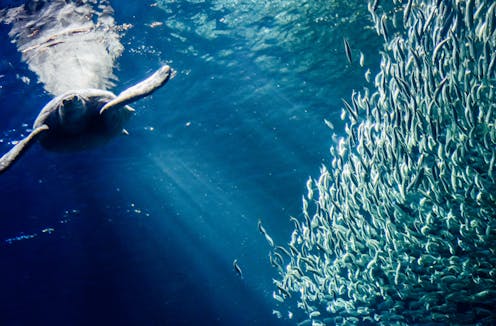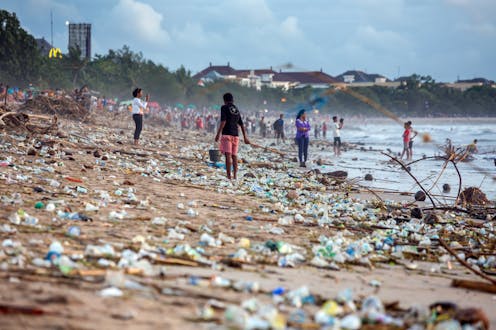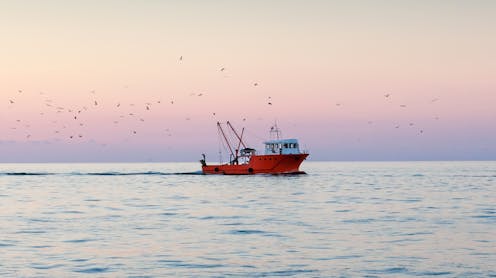Film review: A Plastic Ocean shows us a world awash with rubbish

We live in a world of plastic. Shopping bags, drink bottles, your toothbrush and even your clothes are among the everyday items made from plastic. But plastic isn’t fantastic, and neither is the current state of our environment.
Humans have been mass-producing plastic since the 1950s. We produce hundreds of millions of tonnes of plastic every year and production is only increasing. Unfortunately, most of it is used only once and then thrown away.
Only a small proportion of plastic is recycled. The majority ends up in landfill or, in the worst case scenario, our oceans.
A Plastic Ocean is a documentary film directed by the Australian journalist Craig Leeson. It dives into and investigates the devastating impacts that plastic has caused to our environment, especially our marine life.
What starts off as an adventure to film the blue whale, the largest animal on the planet, leads to the shocking discovery of a thick layer of plastic debris floating in the middle of the Indian Ocean. Craig, alongside Tanya Streeter, a world record-breaking free diver and environmental activist, then travel across the globe to report on the havoc caused by decades of plastic use.
The film presents beautiful shots of the marine environment. This contrasts with footage of heavily polluted cities and dumps full of plastic rubbish. The juxtaposition between these images sends the message that our actions and choices can severely impact the planet. Throughout the film, experts are interviewed to provide further insight into some of the problems derived from plastic.
Impacts of plastic use
Plastic is so widely used because it is durable and cheap. Unfortunately, this durability is the same quality that makes it so detrimental to the environment. Most plastics do not break down chemically. Instead, they break into smaller and smaller pieces that can persist in the environment for an extensive period of time.
Because it is so affordable, developing countries use plastics extensively. However, many regions lack proper waste management, and much of the rubbish is washed into the ocean when it rains. As a result, a large percentage of all plastics in the ocean are due to only a handful of countries. Scientists estimate that more than 5 trillion pieces of plastic are currently floating in our oceans.
Throughout the film, we are shown footage of numerous marine species that have been affected by plastic debris. Marine animals and sea birds often mistake floating plastic for food. Large pieces of plastic, when eaten, can obstruct the animals’ digestive tracts of the animals, essentially starving them to death.
When smaller “microplastics” are ingested, toxins are released and become stored in their tissue. These toxins accumulate up the food chain and can eventually end up on our dinner tables. The consumption of the contaminated seafood can cause many health problems including cancer, immune system problems, and even childhood developmental issues. This is a major problem, as almost a fifth of the world’s population relies on the ocean for their primary source of protein. Society’s huge appetite for plastic is literally poisoning us.
The future of plastics
There is no quick fix for a problem that has grown hugely over the past few decades. The use of plastics is so ingrained in society that it is all but impossible to eliminate them completely.
The film does, however, offer various strategies that can be implemented to reduce the impact of plastics.
Ideally, avoid plastic-containing products as much as possible. Avoid single-use plastic products and recycle whatever you can. Local governments also need to implement a refund scheme for the return of plastic bottles to incentivise recycling.
For unrecyclable plastics, new technology has been developed to convert them into fuel , providing a second life for those plastics.
It is up to us to embrace these changes and move away from the plastic culture. We need to get this problem under control, as it will only become worse as the human population increases. Our marine animals deserve to live in a blue ocean, not a plastic soup.
A Plastic Ocean is touring internationally , including screenings in Brisbane on March 25 and Cairns on March 27.
Gary Truong does not work for, consult, own shares in or receive funding from any company or organization that would benefit from this article, and has disclosed no relevant affiliations beyond their academic appointment.
Ocean Pollution News by The Conversation Australia


Wahoo Skip Bins prides itself on always providing quality customer service- by focusing on responsive communication, timely deliveries, and competitive rates. Wahoo Skip Bins offers a large range of bin sizes and delivers Sydney wide. Call us today!
ABN: 41490770553




